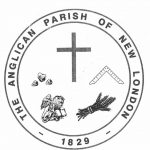Land
In 1838, Sir Gabriel and lady Louisa Augusta Wood and her sisters conveyed to the Society for the Propagation of the Gospel twenty-five acres of land for a church and cemetery to be administered according to the rites and ceremonies of the Church of England. In 1850, Lady Wood gave an additional one hundred acres of land across the road from the church. This glebe land was later sold except for the two acres reserved for the church and cemetery. Eventually, this land was also sold. At the 1895 Annual General Meeting of DCS it was reported that a large portion of the churchyard had been stumped and cleared of stumps and bushes.
Church
The original church built in 1848 still stands, with part of the original timber hewn by Thomas Haslam and his sons. The structure remained virtually unchanged until a chancel was added. The chancel was consecrated by the Right Reverend Hibbert Binney in 1885. In the late 1880s the renowned architect, William Critchlow Harris (1854-1913), ARCA., was contacted to design significant additions in the existing Gothic Style. In 1890, Harris designed the addition to the steeple and the West Wall with a triple lancet window.
For the few times that a hall is required during the year the church can rent the Springfield Community Hall which is located across the highway from the church. A horse shed once stood on the wooded land directly across the road from the church. A school was built adjacent to the church in 1854-1855 which was closed in 1976. The school pupils played in the church parking lot and nearby woods. Consolidation of schools ended the traditional school-church-hall triad in Springfield, but offered attendance at a regional high school.
Cemetery
The first grave used in the graveyard surrounding the church was that of Thomas Haslam’s wife, Elizabeth. Visitors can still see the rectangular white headstones erected for Elizabeth, who died in 1848 and Thomas, who dies in 1865. Each year the parishioners carefully tend the cemetery around the church building.
Architectural Assessment
By Canon Robert C. Tuck, Architectural Historian
This church, built in 1848 just when classical architecture in the Georgian or Colonial style was beginning to give way to the Gothic revival, was extensively remodeled under the direction of architect William Critchlow Harris, JR (1854-1913) in 1892.
In its dimensions and proportions it is typical of other Prince Edward Island Anglican churches built in the 1840s in Crapaud, Milton, Cherry Valley and Port Hill and elsewhere, square or nearly so in its floor plan, with a small, shallow sanctuary extension narrower and lower-roofed that the nave. In Crapaud and Milton the original 1840s churched were demolished and replaced by larger buildings erected to much more sophisticated designs by William Harris. At Springfield, however, he remodeled the original building, and in so doing created a country church unique among Prince Edward Island Anglican churches in that it has classical proportions overlaid with elements of High Victorian Gothic eclecticism (St. Patrick’s Roman Catholic Church at Grand River, which dates from the 1830s, was given similar treatment by Harris shortly before his engagement with St. Elizabeth’s Church).
The changes made by William Harris in St. Elizabeth’s church involved all the windows (with the possible exception of the pretty east window over the communion table); the exterior finish, with sloped buttresses on the north and south elevations and board and batten cladding above a string course in the otherwise shingled western gable; the interior finish, including the pews, panels and mouldings of the doors and windows, and the sanctuary arch – all of which are of characteristic and distinctive Harris design – and the steeple with its two stage tower and four-sided spire.
The windows in the western elevation and the tower are dignified with hood moulds. The entrance doorway is in the tower, and is surmounted by three transom lights (a center one in the shape of a quatre foil flanked by two that are circular) under a Tudor or four-centered arch. The shape of this arch (a favorite Harris device, derived from English Perpendicular Gothic Style architecture) is repeated in the center window in the western elevation, which is filled with plate tracery; in the lower range of the window are three lancets pierced with four roundel openings, the center two of which accommodate quatre foil lights. On either side of this main window are two additional lancet windows, a feature derived from the early English period of the Gothic style, and which the architect had used before (eg. at nearby St. Mark’s church in Kensington), but which he did not use again after use in St. Elizabeth’s church.
The original appearance of St. Elizabeth’s steeple has been obscured by the application of black asphalt roof shingles to the spire (which would have been shingled, probably with a band of scalloped shingled painted in a contrasting color to that of the main structure about half way up) and aluminum strips to the upper stage of the tower. The tower would have been enriched with several string courses near the top, and a band of board and batten cladding. Application of the strips involved some destruction or obliteration of surface detail. The present tilt of the tower could no doubt be corrected, but it is not as serious a fault as the loss of the rich detail and color that was entailed in the use of unsuitable materials in making repairs at tome time in the past. St. Elizabeth’s church is splendidly situated on a small hill, and with proper exterior restoration could easily become an outstanding building in the lovely Prince Edward Island landscape.
